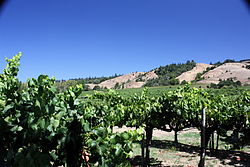| Wine region | |
 A Mendocino County vineyard in the Anderson Valley | |
| Type | U.S. County |
|---|---|
| Year established | 1850 |
| Country | United States |
| Part of | California, North Coast AVA |
| Sub-regions | Anderson Valley AVA, Cole Ranch AVA, Covelo AVA, Dos Rios AVA, Eagle Peak Mendocino County AVA, McDowell Valley AVA, Mendocino AVA, Mendocino Ridge AVA, Potter Valley AVA, Redwood Valley AVA, Yorkville Highlands AVA |
| Total area | 3,878 square miles (10,044 km2) |
| Size of planted vineyards | 15,000 acres (61 km2)[1] |
| Grapes produced | Barbera, Cabernet Franc, Cabernet Sauvignon, Carignane, Charbono, Chardonnay, Chenin blanc, Gewürztraminer, Grenache, Malbec, Merlot, Muscat Canelli, Petit Verdot, Petite Sirah, Pinot blanc, Pinot noir, Riesling, Roussanne, Sangiovese, Sauvignon blanc, Semillon, Syrah, Tocai Friulano, Viognier, Zinfandel[1] |
The Mendocino County wine is an appellation that designates wine made from grapes grown mostly in Mendocino County, California. The region is part of the larger North Coast AVA and one of California's largest and most climatically diverse wine growing regions.[2] Mendocino County is one of the northernmost commercial wine grape regions in the state with two distinct climate zones separated by the Mendocino Range. Ten American Viticultural Areas have been designated within Mendocino County.[3] Mendocino is one of the leading wine growing regions for organically produced wine grapes. Nearly 25% of the acreage in Mendocino County is grown organically.[1][4] In 2004, the residents of the county voted to become the first GMO-free county in the United States in an initiative that was supported by many of the county's largest wineries.[5] The county's widespread focus on organic viticulture has inspired journalists to describe it as "California's organic wine Mecca".[6]
- ^ a b c "Mendocino County: Appellation Description". Appellation America. 2007. Archived from the original on June 7, 2008. Retrieved January 21, 2008.
- ^ Robinson, Jancis; Harding, Julia, eds. (2006). The Oxford Companion to Wine (Third ed.). Oxford University Press. p. 436. ISBN 0-19-860990-6.
- ^ H. Johnson & J. Robinson The World Atlas of Wine pg 272 Mitchell Beazley Publishing 2005 ISBN 1-84000-332-4
- ^ Geniella, Mike (November 2006). "Mendocino County: Home of Organic Wines". Frey Vineyards. Archived from the original (The Press Democrat) on September 3, 2009.
- ^ Kufper, David (March 3, 2004). "GMO = Get Monsanto Out". Alternet News. Archived from the original on June 4, 2011.
- ^ Killen, Roger (February 24, 2008). "Organic wine category grows naturally". Knox News. Archived from the original on July 4, 2008.